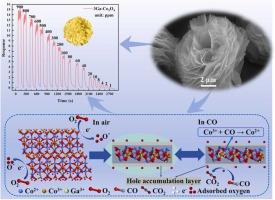Enhancing the surface activity of Co3O4 by gallium doping to increase the sensitivity of conductometric CO gas sensors
IF 8
1区 化学
Q1 CHEMISTRY, ANALYTICAL
引用次数: 0
Abstract
Increasing the surface activity of p-type oxide semiconductors, especially for Co3O4, is essential but challenging to improve the sensing performances toward CO. Herein, a strategy is proposed aiming to increase the surface activity of Co3O4 toward the oxidation of CO through gallium doping by utilizing the wet impregnation and freeze-drying approach. The synthesized Ga-doped Co3O4 (Ga-Co3O4) features a hierarchical structure assembled by nanosheets and a large surface area (65.39 m2/g), which ensures high-efficiency gas interaction and high response to CO. Moreover, the results demonstrate that this strategy promotes the formation of oxygen vacancies and increases the ratio of Co3+/Co2+ in Co3O4, resulting in an enhanced response of 5.8 toward 100 ppm CO, which is markedly higher than that of the bare Co3O4 (1.08). The sensor based on Ga-Co3O4 also presents excellent selectivity toward CO in various interfering gases and a wide concentration detection range of 1–900 ppm. The improved CO sensing performance can be put down to the increased surface activity of Co3O4 via tailoring the content of oxygen vacancy and Co3+ active sites. This study provides new perspectives and strategies for improving the gas-sensing properties of p-type oxide semiconductors.

通过掺杂镓提高Co3O4的表面活性,提高电导CO气体传感器的灵敏度
提高p型氧化物半导体的表面活性,特别是Co3O4的表面活性,对于提高对CO的传感性能至关重要,但也具有挑战性。本文提出了一种策略,旨在通过湿浸渍和冷冻干燥的方法,通过掺杂镓来提高Co3O4对CO氧化的表面活性。合成的ga掺杂Co3O4 (Ga-Co3O4)具有纳米片组装的层叠结构和较大的比表面积(65.39 m2/g),保证了高效的气体相互作用和对CO的高响应。此外,研究结果表明,该策略促进了氧空位的形成,提高了Co3O4中Co3+/Co2+的比例,对100 ppm CO的响应增强了5.8,明显高于裸Co3O4(1.08)。基于Ga-Co3O4的传感器在各种干扰气体中对CO具有良好的选择性,检测浓度范围为1~900 ppm。CO传感性能的提高可以归结为通过调整氧空位和Co3+活性位点的含量来提高Co3O4的表面活性。该研究为提高p型氧化物半导体的气敏性能提供了新的视角和策略。
本文章由计算机程序翻译,如有差异,请以英文原文为准。
求助全文
约1分钟内获得全文
求助全文
来源期刊

Sensors and Actuators B: Chemical
工程技术-电化学
CiteScore
14.60
自引率
11.90%
发文量
1776
审稿时长
3.2 months
期刊介绍:
Sensors & Actuators, B: Chemical is an international journal focused on the research and development of chemical transducers. It covers chemical sensors and biosensors, chemical actuators, and analytical microsystems. The journal is interdisciplinary, aiming to publish original works showcasing substantial advancements beyond the current state of the art in these fields, with practical applicability to solving meaningful analytical problems. Review articles are accepted by invitation from an Editor of the journal.
 求助内容:
求助内容: 应助结果提醒方式:
应助结果提醒方式:


